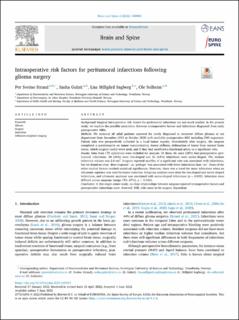| dc.description.abstract | Background
Surgical intraoperative risk factors for peritumoral infarctions are not much studied. In the present study, we explore the possible association between intraoperative factors and infarctions diagnosed from early postoperative MRIs.
Methods
We screened all adult patients operated for newly diagnosed or recurrent diffuse gliomas at out department from December 2015 to October 2020 with available postoperative MRI including DWI sequences. Patient data was prospectively collected in a local tumor registry. Immediately after surgery, the surgeon completed a questionnaire on tumor vascularization, tumor stiffness, delineation of tumor from normal brain tissue, which surgical tool(s) were used, and if they had sacrificed a functional artery or a significant vein.
Results
Data from 175 operations were included for analysis. Of these, 66 cases (38%) had postoperative peritumoral infarctions. 24 (36%) were rim-shaped and 42 (64%) infarctions were sector-shaped. The median infarction volume was 2.4 cm3. Surgeon reported sacrifice of a significant vein was associated with infarctions, but we found no clear “dose-response”, as “perhaps” was associated with fewer infarctions than “no”. None of the other studied factors reached statistical significance. However, there was a trend for more infarctions when an ultrasonic aspirator was used for tumor resection. Subgroup analyses were done for rim-shaped and sector-shaped infarctions, and ultrasonic aspirator was associated with sector-shaped infarctions (p = 0.032). Infarction rates differed across surgeons (range 15%–67%), p = 0.021).
Conclusion
In this single center study, no clear relationships between surgeon reported intraoperative factors and postoperative infarctions were observed. Still, risks seem to be surgeon dependent. | en_US |

